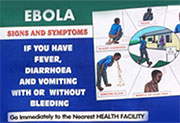
FRIDAY, Aug. 29, 2014 (HealthDay News) — The West African Ebola outbreak took a more deadly turn Friday with the World Health Organization announcing an estimated 500 new cases this week — the biggest jump in infections so far.
Most of the new cases arose in Liberia, the U.N. health agency said, but cases in Guinea and Sierra Leone also rose sharply, the Associated Press reported.
“There are serious problems with case management and infection prevention and control,” according to the WHO report. “The situation is worsening in Liberia and Sierra Leone.”
Senegal — a prime tourist destination in the region — has also now recorded its first case, an infected university student from Guinea who sought treatment at a hospital in Senegal’s capital city, Dakar, the AP reported.
According to Senegal’s Health Minister, Awa Marie Coll Seck, the young man had had contact with Ebola patients in Guinea and has now been placed under quarantine. Tests have confirmed he is infected with Ebola virus, the AP said.
The news follows a WHO update released on Thursday that warned that the deadly Ebola outbreak hitting five West African nations could eventually infect more than 20,000 people.
Already the largest Ebola outbreak ever, the viral infection has produced 3,069 cases so far and killed 1,552 people in Guinea, Liberia, Nigeria and Sierra Leone, with Senegal now added to that list.
Nearly 40 percent of the total number of reported cases have occurred in the past three weeks, the health agency said.
“This far outstrips any historic Ebola outbreak in numbers. The largest outbreak in the past was about 400 cases,” Dr. Bruce Aylward, WHO’s assistant director-general for emergency operations, said at a news conference, the AP reported.
In the meantime, many American universities say they plan to run extra health checks on college students arriving from the affected region.
According to the AP, about 30 students from Nigeria are expected to arrive this semester at the University of Illinois. According to Dr. Robert Palinkas, director of the university’s health center, the Nigerian students will be asked to undergo a temperature check for signs of fever and to have a private discussion about Ebola when they arrive at the university health center for required immunization paperwork and tuberculosis testing.
Health experts stress that the threat to U.S. college students remains very small, but Palinkas told the AP that the added precautions should reassure parents.
“Parents are comforted to know that there is a screening process, that we are alert for it, that we are prepared for it,” he said, “and that we’re doing everything we can without infringing on the rights of anybody to make sure their son or daughter is going to have the lowest risk possible.”
Similar precautions are being conducted at the University at Buffalo in New York, Mercer University in Georgia, Liberty University in Lynchburg, Va., and the University of Akron in Ohio, the AP said.
In response to the crisis, WHO unveiled a battle plan Thursday that calls for stopping Ebola transmissions within six to nine months, while “rapidly managing the consequences of any further international spread,” the WHO said in a news release.
The plan calls for spending $489 million over the next nine months and enlisting 750 international workers and 12,000 national workers, the AP reported.
Also Thursday, the U.S. National Institutes of Health (NIH) said it would begin testing an experimental Ebola vaccine in humans next week. It will be tested in 20 healthy adults in Maryland to see if it’s safe and able to produce an appropriate immune system response.
The vaccine was developed by the U.S. National Institute of Allergy and Infectious Diseases and drug maker GlaxoSmithKline. It will also be tested on healthy volunteers in Great Britain and the West African nations of Gambia and Mali, the NIH said.
Unlike diseases such as tuberculosis or flu, Ebola isn’t spread by breathing air from an infected person. Transmission requires direct contact with blood, secretions, organs or other body fluids of infected living or dead persons or animals, according to the WHO.
Ebola, one of the world’s most virulent diseases, kills up to 90 percent of people it infects. Symptoms include a sudden fever, intense weakness, muscle pain, headache and sore throat. This is followed by vomiting, diarrhea, rash, poor kidney and liver function and, in some cases, both internal and external bleeding.
Many of those killed during the current Ebola outbreak have been health care workers.
According to the CDC, health care workers must be able to recognize a case of Ebola and be ready to use “isolation precautions or barrier nursing techniques.” Barrier nursing techniques include:
- wearing protective clothing, such as masks, gloves, gowns, and goggles;
- using infection-control measures, including complete equipment sterilization and routine use of disinfectant;
- isolating patients with Ebola from contact with unprotected persons.
The aim of these techniques is to avoid contact with the blood or secretions of an infected patient, the CDC said.
More information
For more on Ebola virus, visit the U.S. Centers for Disease Control and Prevention.
Copyright © 2025 HealthDay. All rights reserved.

